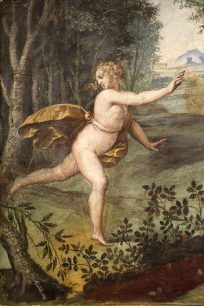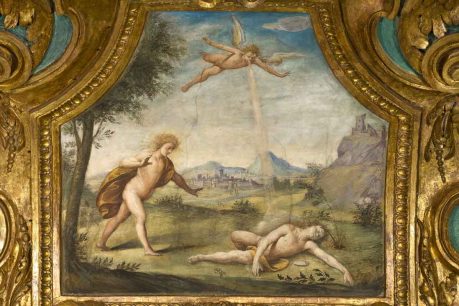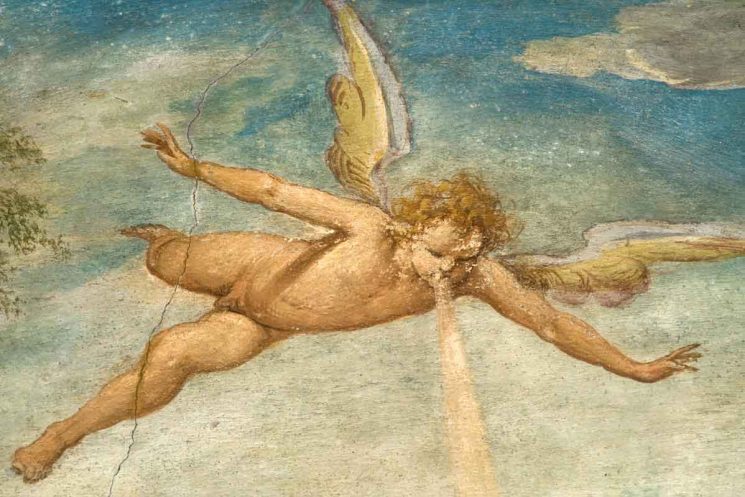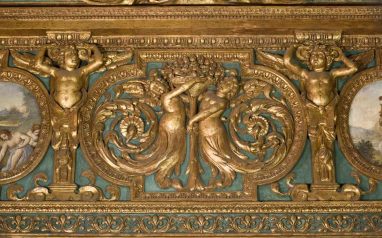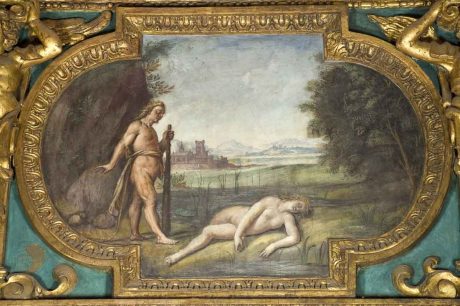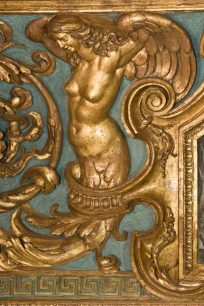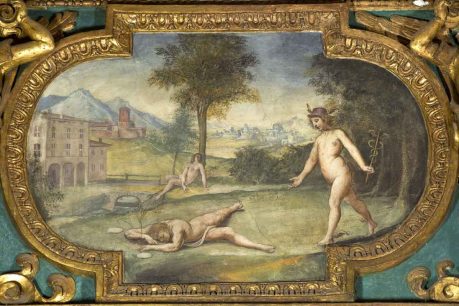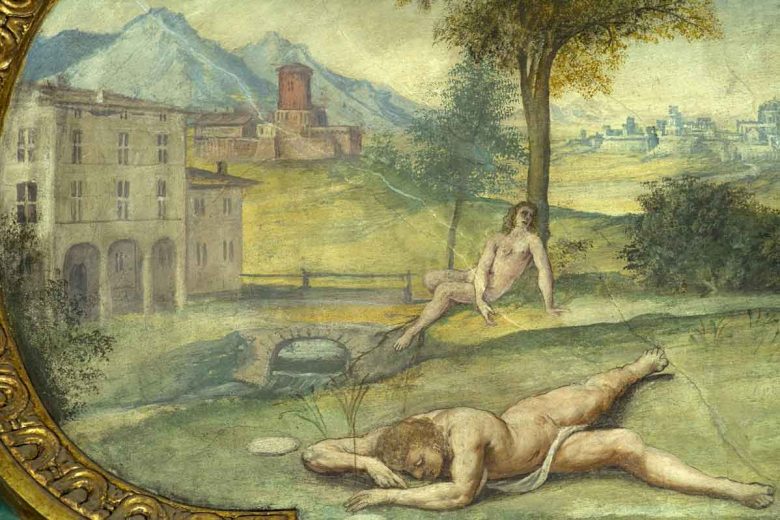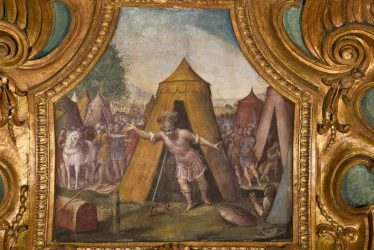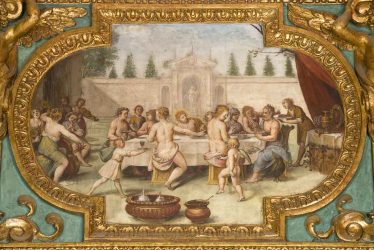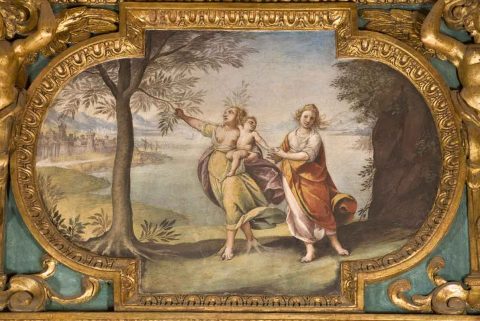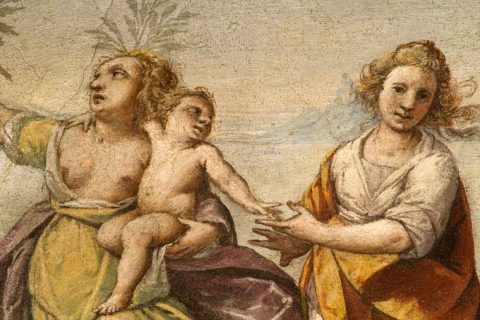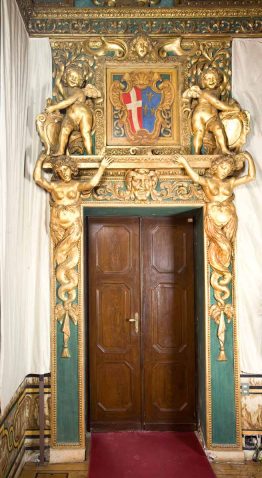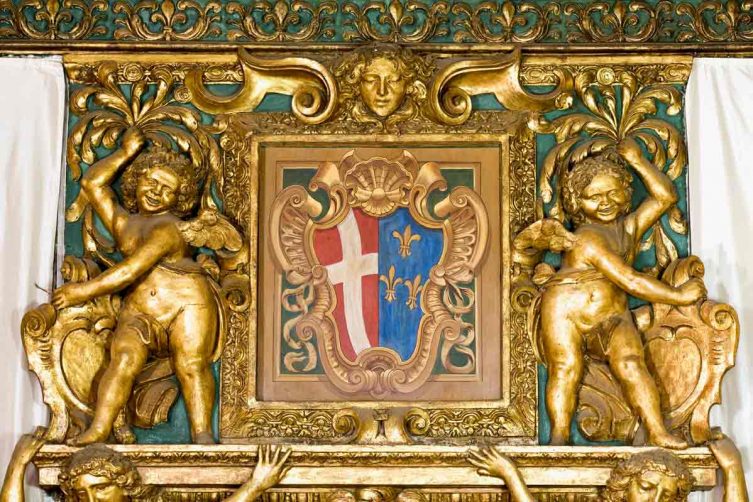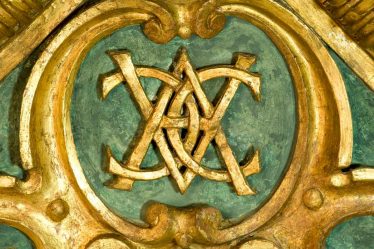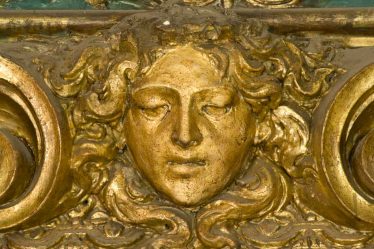The decoration of this room was carried out by Isidoro Bianchi and his team. The 1644 inventory uses the definition ‘green room’ due to the dominating colour of the wall-hanging leather tapestries (green background with golden flowers), and does not use as reference the subject of the painting in the centre of the ceiling, as is the case with the other rooms in the apartment. This leads us to consider the symbolic value of the colour, which is quite evident in all the fresco panels especially in the clothes worn by the characters appearing in them. Bright green symbolises the arrival of spring and a much darker green re-presents death and life-after-death. The fresco in the centre of the ceiling also seems to have a dual message as it represents both the triumph of Flora through the city’s offering to Maria Cristina (this is how Marini saw it and as well as the nineteenth century restorations), together with other significance, not particularly hidden showing darker events. The picture takes on a funerary aspect owing to the presence of a big bull adorned with floral garlands, accompanyed by three maidens that evoke sacrifical victims. However the painting in the sky of the zodiacal sign of Taurus suggests the re-birth of the bull. Vittorio Amedeo I was born under this sign and his death in 1637 probably prompted this painting. Flora – Maria Cristina, wearing dynastic French-Savoy colours of white, red and blue is no longer represented as she is in the “Where Flowers Are Born” Room happily walking through a world of flowers; but sitting with her arms open wide, her face drawn and tired, surrounded by heavy shadow and near her are empty vases or vases with wilting flowers (a white and a red Fleur-de-lis). The frames and the motifs in the stucco-work decoration which divide the ceiling and the final border at the top of the walls also cleverly connect frescoed and plastic decoration, and this balance shows a compact and unitary piece of work as confirmed by recent restaurations. But if we study Marini’s eighteenth century sketch, we are perplex by a lot of details carried out on a single parts of framing and on single decorative elements. If the female figures and the vegetal-limbed putti are found in both images, and fit in with the seventeenth century style, the shape of the frames of the panelled frescos and the figures themselves appear quite different, in fact are more similar to pre-nineteenth century style. The ceiling and the decorated border at the top of the walls are perfectly in keeping with each other and their individual stucco-work and fresco panels have the same importance and value. A pair of acanthus-limbed putti and a painted scene alternate in panelling of the same shape over the border at the top of the walls. The metamorphosis in the stucco-worked figurines represents an ulterior link with the subjects in the frescos mythologcally connected to the birth of plants and flowers described in Ovidio’s ‘Metamorphosis’. This is another ambiguity which dominates this room.
In the four frescos painted on the ceiling there are: Hyacinthus, on the ground having been hit by the discus thrown by the Phoebus, and whose blood generates the flower of the same name (Hyacinth); Pyramus and Thisbe separated by a river of blood and from which a bright red Lily is growing; Prometheus whose liver is being eaten by an eagle, and then renewed and then eaten again, is depicted here lying on the ground with his chest torn open and Jonquils (Daffodils) growing where his blood falls; and Ajax, unable to stand not being awarded a war-trophy, throws himself on his sword and from his blood a red Hyacinth grows. All four stories show the theme of a hero’s death and his re-generation in the form of a flower which immediately brings to mind, once again, the death of the Savoy hero Vittorio Amedeo in 1637. This adds to the already commemorative aura of the room. The paintings in the border at the top of the walls were also inspired by Ovidio’s Metamorphosis, but were further enriched by d’Agliè in paintings where the female presence is more significant than the male’s. On the western wall there is, as d’Agliè describes “Helena resting on a tombstone, crying and from her tears Elenii is born” and King Midas’ Banquet. On the southern wall there is .Venus on a chariot pulled by swans and accompanied by Eros. At their feet grow a white and a red lily (according to d’Agliè’s explanation); Narcissus is looking at his reflection in the spring-water and flowers of the same name, Narcissus (or Daffodils) are growing on the bank nearby. On the eastern wall we find Hercules and Mercury and, finally on the northern wall there is Driope, with his son Anfisso and sister Loti at the moment when, having collected the branches of a lotus plant (which had just been transformed from a nymph), he is turned into one too. And finally the myth of Clizia, who having been turned into a sunflower, continues to face the sun.
The interlaced monogrammes of Vittorio Amedeo and Cristina on the corners of the frame of the central fresco in the ceiling, suggest a decided reference to the complex affairs of the ducal family between 1637 and 1640. These years were characterised by the death of the duke, and his wife Maria Cristina’s defence of her power once she had become Regent and her determination to preserve this power and hand it down to her son. The city’s offer to the duchess, the hero myth and the continuation of life after death, suggest this room was destined for official Regency use – it is no coincidence it immediately adjoins the great salon where the whole heroic Savoy history is celebrated.


